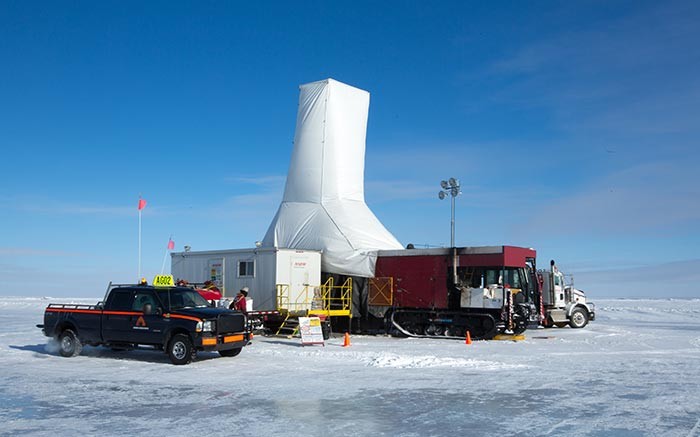Dominion Diamond’s (TSX: DDC; NYSE: DDC) prefeasibility study for the Jay kimberlite pipe deposit shows it could add 11 years to the life of its Ekati diamond mine in the Northwest Territories’ Lac de Gras region.
Given its size and high grade, the Jay pipe is the most important undeveloped deposit at the mine. It is Ekati’s “primary life of mine extension opportunity,” BMO analyst Edward Sterck writes.
Dominion owns 88.9% of the Core zone — comprising the Ekati mine and other permitted kimberlite pipes — as well as a 65.3% interest in the Buffer zone, an adjacent area hosting prospective kimberlite bodies, such as the Jay and Lynx kimberlite pipes.
The study envisions developing Jay as a stand-alone open-pit operation at an initial start-up cost of US$657 million. Once ramped up, Jay would deliver 4.3 million dry tonnes a year to the existing processing plant, starting after the anticipated closure of the existing Ekati mining operations in 2020.
Over Jay’s estimated 11-year life, Dominion would recover 45.6 million tonnes of ore grading 1.9 carats per tonne to produce 84.6 million carats.
Using the average prices from its 2014 rough diamond sales, and from the diamond recovery profile of the Ekati plant, Dominion has priced Jay’s diamonds at US$64 per carat. That includes a real 2.5% annual escalation from the average 2014 price over the life of mine.
Total operating costs per tonne processed would average US$75, implying a margin of US$47 per carat produced.
According to the study, Jay has a post-tax net present value (NPV) of US$610 million (on a 100% basis) and a post-tax internal rate of return of 16%, using a 7% discount rate and an average diamond price of US$86 per carat.
Sterck notes this NPV is below his estimate of US$750 million, at a 10% discount, as the lower-than-anticipated capex is being offset by higher-than-expected operating costs.
That said, the analyst adds that the lower anticipated start-up costs “de-risks project development, and allows for greater returns to shareholders as the Misery pipe enters production in calendar 2016 . . . Pre-Jay capex, BMO Research forecasts total free cash generation in excess of US$2 billion over the next four years for Dominion.”
The Jay pipe, which sits beneath the moderately sized lake Lac du Sauvage, is roughly 7 km northeast of the Misery pit and 30 km southeast of the Ekati mine.
To develop Jay, Dominion will need to build a water retention dike around the pipe to allow for the dewatering of area before it can be pre-stripped and mined. The study estimates 56% of the initial costs, or US$368 million, would go towards constructing the dike and related infrastructure, including roads and pumps.
Dominion expects to permit the Jay pipe in 2016, with construction slated to start in the second half of 2016, followed by dewatering and pre-stripping in 2019. Mining and processing are set to start in 2020. During that year, Jay could supply about half of the ore to the plant, as Jay is ramped up and Ekati’s pre-existing reserves are depleted.
The pre-stripping cost for the first phase of mining at Jay would be US$33 million and is not part of the initial costs. The life of mine strip ratio is 4-to-1. Sustaining capital is pegged at US$148 million.
The company reported Jay’s first reserve statement and an updated resource estimate with this new study. The pipe has reserves of 84.6 million carats from 45.6 million tonnes grading 1.9 carats per tonne. It has 90.6 million carats from 48.2 million indicated tonnes at 1.9 carats, plus 8.6 million carats from 4.2 million inferred tonnes grading 2.1 carats.
Dominion shares closed Jan. 30 at $21.11, near a 52-week high of $21.62 reached earlier in the month.
Sterck has a $25 target on the stock, with an “outperform” rating.


Be the first to comment on "Jay pipe could add 11 years to Ekati mine life"